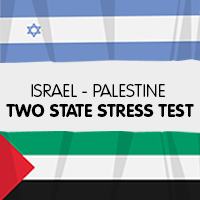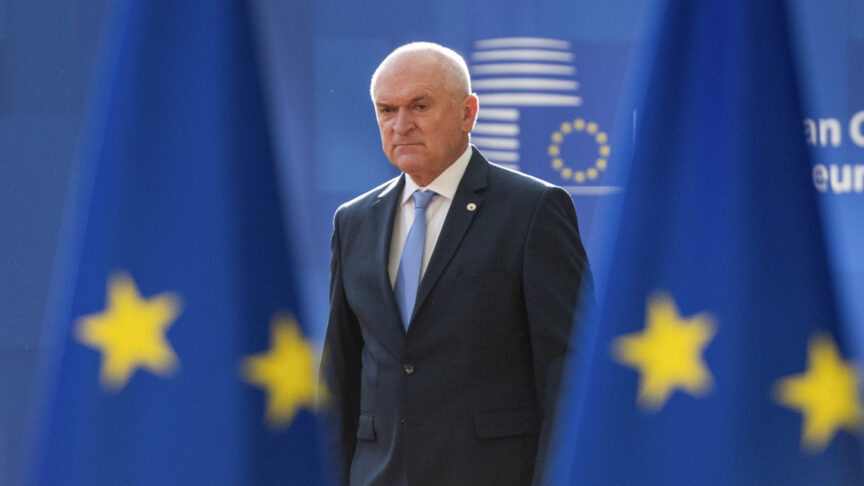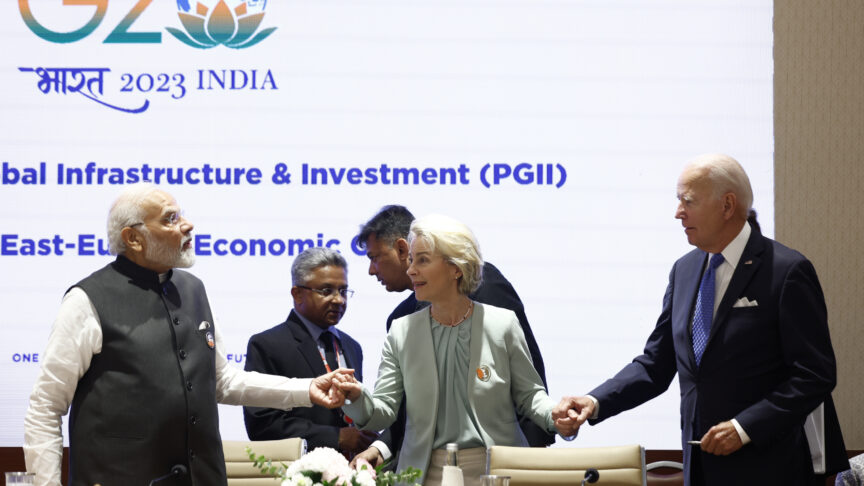The Two-State Stress Test
ECFR's new innovative project – the Two-State Stress Test – provides an annual health-check on whether developments across seven different areas are serving to strain or sustain a possible two-state outcome for the Israeli-Palestinian conflict.
 This week ECFR launched the Two-State Stress Test (TSST) an annual health-check on whether developments across seven different areas are serving to strain or sustain a possible two-state outcome for the Israeli-Palestinian conflict.
This week ECFR launched the Two-State Stress Test (TSST) an annual health-check on whether developments across seven different areas are serving to strain or sustain a possible two-state outcome for the Israeli-Palestinian conflict.
This comes at a very timely moment in US-led negotiations between Israel and the Palestinian Liberation Organization (PLO). The TSST aims to focus decision-makers’ attention on those factors that currently strain the prospects for the two-state solution, and which may come further to the fore when the next prisoner release takes place possibly before the end of the year.
The prisoner release will likely be the occasion for further settlement announcements and consequent hand-wringing on the Palestinian side. At the moment the largest strain on prospects for the two-state solution comes from two issues that have been highlighted in the Two-State Stress Test: the territorial issue and particularly the continued expansion of Israeli settlements both in the West Bank and in East Jerusalem – at a conspicuously faster pace since talks have resumed; the dynamics of the Israeli political and public debate, which combines little public confidence in the talks, cabinet and ruling coalition members openly opposing two states and advocating different variations on annexation of the West Bank, and tepid popular support for commonly agreed parameters for a two-state solution.
The factor that comes out as most sustaining the two-state solution at the moment is the renewed US-led diplomatic efforts, which were again on display last weekend when both US President Barack Obama and Secretary of State John Kerry addressed a US-Israel forum in Washington along with last week’s visit by Kerry to Israel/Palestine, the seventh since he was appointed. The Two-State Stress Test indicates that a lessening of this intensity would leave the prospects for the two-state solution even more fragile.
This annual two-state prospects health-check shows a gradually worsening situation from more obvious factors such as East Jerusalem and security, while also shining a spotlight on factors too infrequently taken into consideration: the Palestinian political and public debate and the refugee issue. While there is still a slim majority of Palestinians supporting in principle the two-state solution, there is very little faith in the chances of it being achieved through a negotiated settlement. The refugee issue, though often neglected both by negotiators and media, is potentially a source of crisis both because of the worsening conditions of refugees (also as part of the fallout of the war in Syria) and because Israeli and Palestinian public opinions seem to be very far apart on ideas for a solution of this issue.
Two-State Stress Test – Factsheet
Categories are scored from 0 (maximum sustain for the two-state solution) to 5 (maximum strain for the two-state solution).
Territory: score 4
- The number of settlers in the West Bank continues to grow, at a higher speed than natural population growth in Israel. According to data from July 2013, the most recent estimates, there are 367,000 settlers in the West Bank (excluding Jerusalem), 7,700 of those are new residents from January-July 2013.
- If these estimates are confirmed, this would show a 6.68 percent increase over 2012 when, according to the Central Bureau of Statistics, 341,400 settlers lived in the West Bank and is significantly higher than population growth in Israel proper which was 1.8 percent in 2012, in line with previous years.
- The first six months of 2013 saw a 70 percent increase in new construction starts in settlements compared to the same period in 2012. In total, 2,840 housing units were started, under construction, or completed during this period only in the West Bank.
- Between March and July 2013 the Ministry of Defense approved the construction of an additional 2,487 housing units in West Bank settlements, which came on top of the 6,200 units approved between November 2012 and March 2013.
- While the number of permanent checkpoints has remained stable since 2012, at 61, Israeli authorities erected 2,400 flying checkpoints over the course of the first ten months of 2013, amounting to a rate of 240 per month, higher than the 213 recorded in the last quarter of 2012.
- Israeli authorities demolished a total of 413 structures in Area C of the West Bank between January and September 2013, resulting in the displacement of 615 Palestinians. International donors financed 99 of the 413 demolished structures.
East Jerusalem: score 3
- Despite occasional claims of an undeclared settlement freeze in East Jerusalem, the Israeli government issued tenders for 1,618 housing units in the settlements of Pisgat Ze’ev, Har Homa, Gilo, and Ramat Shlomo. Noteworthy is that all of these tenders were issued over a period of four months, from August to November, when talks were underway.
- There has been a rise in demolitions and evictions of Palestinians in East Jerusalem. From January to September 2013, Israeli authorities demolished 80 structures in this part of the city, resulting in the displacement of 257 people. This amounts to a monthly rate of nine demolitions, up from five in 2012, and 28 Palestinians displaced, up from six in 2012.
Diplomacy: score 2
- Since Barack Obama’s first presidential visit to Israel and the West Bank in March 2013, the US has entered a period of intense engagement. US Secretary of State John Kerry has visited Israel and the West Bank seven times since his appointment in February 2013 and also meeting Israeli and Palestinian leaders elsewhere, as with Netanyahu in Rome. By way of comparison, former US Secretary of State Hillary Clinton visited Israel and the OPTs five times between 2009 and 2012. While the US has succeeded in launching peace negotiations based on a nine-month timeline for final-status negotiations, both sides have been unable to agree to clear terms of reference or a negotiating agenda that builds on previous talks.
- The EU’s decision to issue guidelines excluding settlements from EU projects along with increasing talk of labelling settlement products, and the consequent alarm this has provoked amongst Israelis, represent a potentially significant milestone in attempts to alter Israel’s cost/benefit calculations towards the occupation – although the extent to which the EU will apply its leverage remains unclear.
Security: score 3
- Palestinian violence was limited during the first half of 2013, almost reaching the level of security enjoyed by Israel in 2012, when no Israelis died in the West Bank. The second half, however, saw an up-tick in “lone-wolf” attacks, resulting in the killing of nine Israelis by November (including one fatality inside Israel), understandably a cause for Israeli concern.
- Israeli state violence has also remained limited (19 Palestinian fatalities) and, despite occasional flare-ups in Gaza, the November 2012 ceasefire between Israel and Hamas has largely held.
- Since the beginning of 2013, Palestinian factions have fired a total of 87 projectiles towards Israel from the Gaza Strip and the Sinai Peninsula. This represents 3.42 percent of those fired in 2012.
- The number of settler attacks on Palestinians in 2013 is similar to levels witnessed in 2012. While prosecution of those committing these crimes has remained very low, the Israeli government claims to be taking more steps to crack down on settler violence.
Refugees: score 3
- In June 2013, 42 percent of Palestinians polled ranked the “end of the occupation” as the priority, followed by 34 percent who thought the right of return for refugees “to their 1948 towns and villages” was more important.
- A December 2013 poll found that almost all Palestinians (92 percent) think that at least an acknowledgment in principle of the right of return is needed in order to make a peace deal “tolerable”, while a majority is ready to compromise on the implementation of the right of return.
- Only 15.3 percent of Jewish Israelis support a limited return for Palestinian refugees and only 23.9 percent agree that Israel should accept partial historical responsibility for the suffering of Palestinian refugees.
- In his 6 October speech at Bar Ilan University, Prime Minister Benjamin Netanyahu said that Palestinians must drop their requests on the right of return if peace is to be achieved. According to a December 2013 poll, 55 percent of Israelis (and 63 percent of Jewish citizens) agree with him.
The Palestinian debate: score 3
- 55 percent of Palestinians from the OPTs said in March 2013 that they supported a two-state solution.
- Asked in November 2013 whether they think that the current talks will lead to an agreement, 11 percent of Palestinians from the OPTs said that this would happen in one year, 19 percent predicted that this would happen in five years, and 22 percent said that an agreement is inevitable but that it would take more than five years; 47 percent, meanwhile, said that they did not believe that a peace agreement would ever be reached.
- According to the findings of a November 2013 poll, 50.5 percent of Palestinian respondents said that the PLO should not have agreed to restart talks, while 33.8 percent voiced their support for talks.
The Israeli debate: score 4
- In June2013, 62 percent of Israelis supported the two-state solution, with 65.3 percent of Israelis supporting negotiations two months after their resumption.
- Only 28.8 percent of Israelis think that a two-state solution can be achieved through negotiations; 51 percent of Israelis think that it is absolutely impossible to reach a final status agreement with the Palestinians; and 68 percent said that this would be impossible to achieve in the next five years.
- Only 10 percent of Israelis ranked negotiations as a top priority for Israel, making this the fifth most important issue on the political agenda for Israelis, behind reducing the national deficit (12 percent), public order and violence (14 percent), the Iranian nuclear threat (16 percent), and the top item of the agenda, closing socio-economic gaps (39 percent)
- Government figures continued to express support for variations on a one-state solution, including, for the first time, a senior government minister – Minister of Economics and Trade Naftali Bennett – who persistently and repeatedly called to abandon the two-state process and opt for partial annexation instead.
The European Council on Foreign Relations does not take collective positions. ECFR publications only represent the views of their individual authors.


